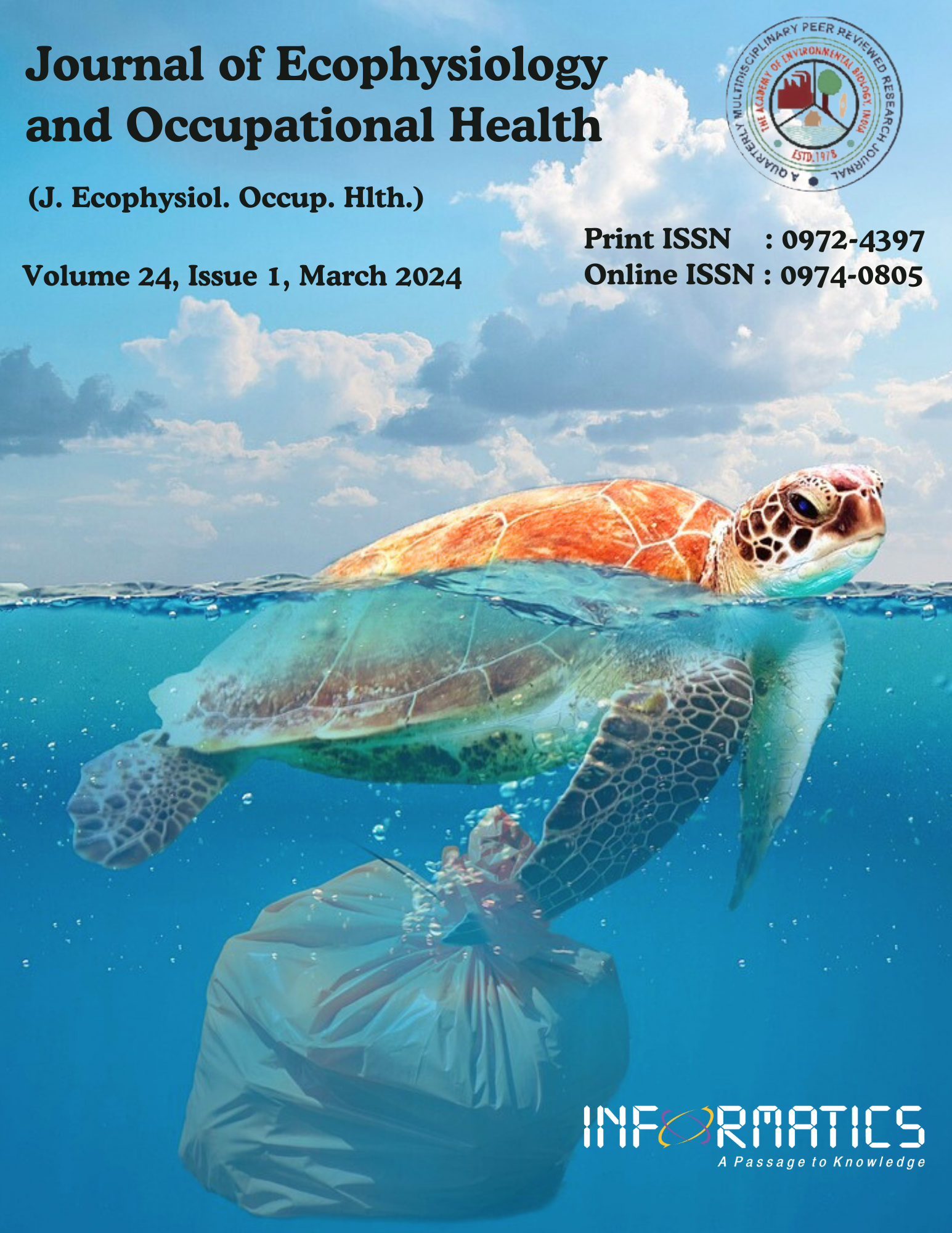Effect of Work-Based Exercise Program Among Industrial Workers having Non-Specific Neck Pain Using ICF Core Set: A Pre-Post Experimental Study
DOI:
https://doi.org/10.18311/jeoh/2024/35756Keywords:
Ergonomics, Head Posture, ICF Model, Industrial Workers, Neck Pain, Nonspecific Neck Pain, StretchingAbstract
Unfortunately, there are many causes of neck pain, the most prevalent ones are long periods of sitting, bad workplace ergonomics and keeping an unnatural neck posture. Studies show that small-scale industries lack awareness of and comprehension of ergonomics. Unpredictable schedules, long hours, hazardous workplaces, and all these problems, including inadequate vocational training, may negatively impact employees’ HRQOL and restrict their capacity to take part in and carry out activities. Progressive resisted training, neuromuscular training exercises, stretching, and ergonomic recommendations are all recommended. To enhance the quality of life of industrial workers, fitness programs must be implemented. The aim is to ascertain how a work-based exercise program affects industrial workers with nonspecific neck discomfort in terms of activity limitation and participation restriction. To determine the risk of nonspecific neck discomfort among industrial workers, the RULA scale was administered to 92 individuals in the study who had VAS values ranging from 3-6. Neck ROM was also recorded. An ICF documentation form was used to ascertain the engagement and involvement. Over the course of two weeks, the subjects received a work-based exercise program on alternate days. ROM, RULA, and ICF documentation were among the outcome variables that were assessed both before and after the intervention. The result was that there was a noteworthy distinction noted between the RULA, ROM pretest and post-test scores as well as ICF codes. Differences between the pre and post-test of VAS were significant difference (Z=8.3290, p=0.0001). To conclude the study found that industrial workers lacked knowledge about ergonomics. Therefore, exercises and ergonomics helped manage neck pain and improve the range of motion.
Downloads
Metrics
Downloads
Published
How to Cite
Issue
Section
License
Copyright (c) 2024 Prashant Naik, Omkar Ghadi, Robins Kumar, Aishwarya Wayadande, Sunil Harsulkar, Sheetal Swamy, Anuja Khadilkar

This work is licensed under a Creative Commons Attribution 4.0 International License.
Accepted 2024-01-02
Published 2024-03-04
References
Das B. Prevalence of work-related musculoskeletal disorders among the brick field workers of West Bengal, India. Archives of Environmental and Occupational health. 2014; 69(4):231-40. https://doi.org/10.1080/19338244.2013 .771249 PMid:24499251 DOI: https://doi.org/10.1080/19338244.2013.771249
Cohen SP. Epidemiology, diagnosis, and treatment of neck pain. Mayo Clinic Proceedings. 2015; 90(2):284-99. https:// doi.org/10.1016/j.mayocp.2014.09.008 PMid:25659245 DOI: https://doi.org/10.1016/j.mayocp.2014.09.008
Hoy D, March L, Woolf A, Blyth F, Brooks P, Smith E, Vos T, Barendregt J, Blore J, Murray C, Burstein R. The global burden of neck pain: Estimates from the global burden of disease 2010 study. Annals of the rheumatic diseases. 2014; 73(7):1309-15. https://doi.org/10.1136/annrheumdis 2013- 204431 PMid:24482302 DOI: https://doi.org/10.1136/annrheumdis-2013-204431
Rahman CM. Study and analysis of work postures of workers working in the ceramic industry through Rapid Upper Limb Assessment (RULA). International Journal of Engineering. 2014; 5(3):8269.
Pathan NM, Thakur S, Kadam K, Lohade S, Chandak N. Immediate effects of positional release therapy and manual trigger point release on neck pain and range of motion in computer users with upper trapezius. Journal of Family Medicine and Primary Care. 2021; 10(8):2839. https:// doi.org/10.4103/jfmpc.jfmpc_1608_20 PMid:34660415 PMCid: PMC8483136
Bijur PE, Silver W, Gallagher EJ. Reliability of the visual analogue scale for the measurement of acute pain. Academic Emergency Medicine. 2001; 8(12):1153-7. https://doi. org/10.1111/j.1553-2712.2001.tb01132.x PMid:11733293 DOI: https://doi.org/10.1111/j.1553-2712.2001.tb01132.x
Farooq MN, Bandpei MA, Ali M, Khan GA. Reliability of the universal goniometer for assessing an active cervical range of motion in asymptomatic healthy persons. Pakistan Journal of Medical Sciences. 2016; 32(2):457. https://doi. org/10.12669/pjms.322.8747 PMid:27182261 PMCid: PMC4859044 DOI: https://doi.org/10.12669/pjms.322.8747
McAtamney L, Corlett EN. RULA: A survey method for the investigation of work- related upper limb disorders. Applied Ergonomics. 1993; 24(2):91-9. https://doi. org/10.1016/0003-6870(93)90080-S PMid:15676903 DOI: https://doi.org/10.1016/0003-6870(93)90080-S
Mohamad D, Md Deros B, Ismail AR, Daruis DD, Sukadarin EH. RULA analysis of work-related disorders among packaging industry workers using Digital Human Modelling (DHM). Advanced Engineering Forum. 2013; 10:9-15. https://doi.org/10.4028/www.scientific.net/ AEF.10.9 DOI: https://doi.org/10.4028/www.scientific.net/AEF.10.9
Cox LG, Savur KT, De Nardis RJ, Iles RA. Progressive resistance exercise for improving pain and disability in chronic neck pain: A case series. Physiotherapy Research International. 2020; 25(4):e1863. https://doi.org/10.1002/ pri.1863 PMid:32648340 DOI: https://doi.org/10.1002/pri.1863
Alfawaz S, Lohman E, Alameri M, Daher N, Jaber H. Effect of adding stretching to standardized procedures on cervical range of motion, pain, and disability in patients with nonspecific mechanical neck pain: A randomized clinical trial. Journal of Bodywork and Movement Therapies. 2020; 24(3):50-8. https://doi.org/10.1016/j.jbmt.2020.02.020 PMid:32826008 DOI: https://doi.org/10.1016/j.jbmt.2020.02.020
Pathan NM, Thakur S, Kadam K, Lohade S, Chandak N. Immediate effects of positional release therapy and manual trigger point release on neck pain and range of motion in computer users with upper trapezius. Journal of Family Medicine and Primary Care. 2021; 10(8):2839. https:// doi.org/10.4103/jfmpc.jfmpc_1608_20 PMid:34660415 PMCid: PMC8483136 DOI: https://doi.org/10.4103/jfmpc.jfmpc_1608_20
Aghilinejad M, Kabir-Mokamelkhah E, Labbafinejad Y, Bahrami-Ahmadi A, Hosseini HR. The role of ergonomic training interventions on decreasing neck and shoulders pain among workers of an Iranian automobile factory: A randomized trial study. Medical journal of the Islamic Republic of Iran. 2015; 29:190.
Andelic N, Johansen JB, Bautz-Holter E, Mengshoel AM, Bakke E, Roe C. Linking self-determined functional problems of patients with neck pain to the International Classification of Functioning, Disability, and Health (ICF). Patient preference and adherence. 2012; 749-55. https:// doi.org/10.2147/PPA.S36165 PMid:23118531 PMCid: PMC3484528 DOI: https://doi.org/10.2147/PPA.S36165
 Prashant Naik
Prashant Naik







